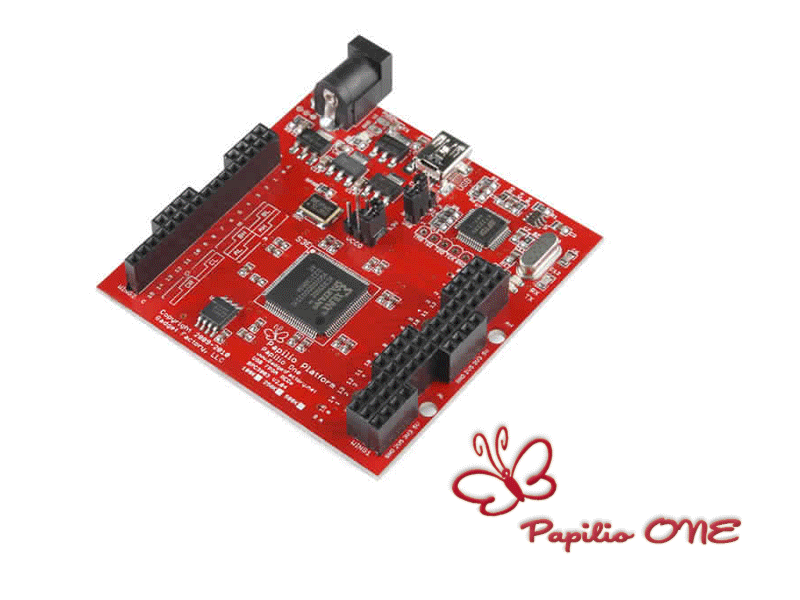Papilio Wiki
Welcome to Gadget Factory's Papilio Wiki, Papilio is an open-source hardware and software project that puts the awesome power of an FPGA into your creative arsenal.
We live in exciting times where we can create masterpieces with the Arduino and marvels with the Raspberry Pi. Where we can use technology as a canvas to create things that amaze and amuse our friends and family. Wouldn't it be great if we could take the same technology that has been the staple of rocket scientists and put it in our creative arsenal? Without the need to become a rocket scientist or the headache of learning a new programming language like VHDL/Verilog.
Why can't we just draw up the circuits that we want to use? With the right software and circuit libraries we can! Let's put a full circuit lab on a chip, pair it with an easy to use Arduino-Compatible chip, and sprinkle in a generous helping of debugging tools.
FPGA Unleashed!
Our dream is to take the hardcore out of FPGA (Field Programmable Gate Array) and make it an amazing tool that anyone can use for creative technology projects.
Just like the Arduino team simplified C++ programming, we simplify FPGA design by providing easy to use drag and drop circuit libraries. We believe that drawing circuits will result in an amazing outpouring of creative FPGA projects!
Use the Papilio to unleash your inner DaVinci. Draw and debug circuits on a chip without any soldering, breadboarding, or weird programming languages. Set your imagination free and put an FPGA in your creative arsenal!
What are Papilio MegaWings?
MegaWings are an exciting addition to the Papilio family of FPGA boards that are similar to Arduino Shields. They provide all the hardware needed for a targeted FPGA application such as recreating arcade games, experimenting with FPGA synthesizers, or even learning VHDL.
What are Papilio Wings?
The Papilio Platform was designed from the ground up to make it easy to add hardware to your FPGA circuits using what we call Wings. Wings are like mini-Arduino shields that let you add peripherals Ala-Carte as you need them without wasting pins.
Software and Features
The Papilio is much more then just a hardware project. In fact, the software is the secret sauce that sets the Papilio apart from other FPGA boards. It lets you draw up circuits without investing time and energy in learning VHDL/Verilog.
We start with the Arduino IDE (Integrated Development Environment) and supercharge it by adding circuits into the mix. We bring all of the pieces needed to draw and debug your very own circuits in one place. It's an easy and seamless user experience that we call Papilio DesignLab for use with both Windows and Linux.
Papilio DesignLab
We start with the Arduino IDE but every sketch now has a circuit associated with it - editing and debugging circuits is just a click away!

Simply draw and debug your circuits!
Click on the "Edit Circuit" button and simply draw your circuits using the Xilinx ISE schematic editor and our Papilio Circuit Library.

Logic Analyzer
Drop a professional quality Logic Analyzer into any circuit and know instantly what it's doing. Up to 32 channels and 200Mhz speed handles any circuit you can throw at it. Use up to 75KB of internal memory or the external SRAM memory.

System on Chip - Draw Soft Processor Circuits!
Want to get into more complex circuits? DesignLab includes the ZPUino Soft Processor with a Wishbone bus, providing greater speed and flexibility than the Arduino-Compatible chip. A Soft Processor runs inside the FPGA and uses the Wishbone bus to make it easy to connect peripheral circuits, such as UARTs, PWMs or SPI masters. Making your own Soft Processor with just the right mix of peripheral circuits is known as a SOC (System On Chip) design. With DesignLab you can draw your SOC designs in minutes!
Create SOCs with ten serial ports, or a PWM on every pin, or something exotic like classic Atari and Commodore audio chips connected at the same time. The sky is the limit, you can create things that don't exist anywhere else!
Example of making your own SOC design with ZPUino and a Commodore 64 SID audio chip. (This tutorial was written for an earlier version of our software. DesignLab integrates circuits and sketches together for a much easier and seamless user experience.)
Papilio Circuit Library
Drawing circuits can only accomplish so much without a library of circuits (known as cores) to do the heavy lifting. Our goal is to provide the framework for anyone to write a core that can be wired into a circuit.
We want to seek out the best open source circuits on the interwebs and convert them to a dead simple schematic library. The internet is absolutely full of open source circuits; just take a look at sites like OpenCores.com. You will find everything from classic audio chips to stepper motor controllers. All of these amazing circuits are within our reach when converted to schematic form!
Take a look at what is already available in the beta version of DesignLab. (Cores colored in red are still in progress.)


